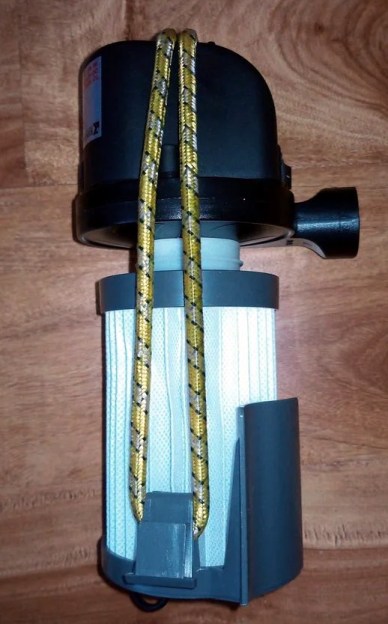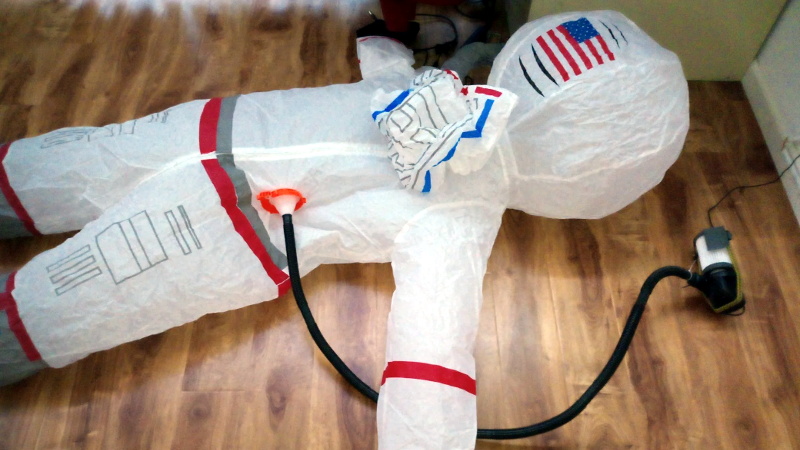As a general rule, you probably shouldn’t be getting your Personal Protective Equipment (PPE) from the party store. But these are exceptional times, and rather than potentially depriving medical professionals the equipment they so desperately need on the front lines, the team at [Robots Everywhere] has been looking into improvised PPE. We’re not sure things are at the point where you would need to don this DIY Positive Pressure Suit (PAPR), but it’s certainly an interesting look at what’s possible when you think outside the box.
 At the most basic level, a PAPR is a mostly air-tight garment that is continuously pumped full of filtered air. As long as the pressure inside the suit is higher than outside, there’s no way airborne bacteria and viruses can get in without traveling through the filter first.
At the most basic level, a PAPR is a mostly air-tight garment that is continuously pumped full of filtered air. As long as the pressure inside the suit is higher than outside, there’s no way airborne bacteria and viruses can get in without traveling through the filter first.
For this project, the folks at [Robots Everywhere] took an inflatable astronaut costume and replaced the dinky original air pump with a much larger 12 V unit designed for inflating air beds. Upgrading the pump not only increased the internal air pressure of the suit, but also made it easier to add a HEPA filter to the inlet. As long as the suit is inflated and there are no leaks in the hose, the wearer will be surrounded by a bubble of filtered air.
Presumably, you don’t want to be tethered to the wall though, so the write-up briefly touches on how the pump system can be made more mobile with the addition of an RC-style battery pack. With the pump and batteries secured in a pouch attached to the suit, the wearer is free to venture outside the confines of their self-isolation bunker and go about their dystopian daily business.
A getup like this might seem a bit excessive, but with so many folks desperate for information on homemade protective gear, we aren’t passing any judgment. The team says you can modify a cheap painter’s suit in much the same way, but frankly, that doesn’t sound nearly as fun to us.
[Thanks to Aron for the tip.]
















But if you _are_ infected (and don’t know it), you’re going to be going to be emitting your virus far and wide.
Run the exhaust through a tube with a UV lamp.
I don’t think there is an exhaust – these party costumes work by continually bleeding air through the whole body’s fabric and stitches.
It wouldn’t be exposed to the UV long enough.
As he fastened the last button on his Super-Spreader costume, he suddenly realized: He was history’s first costumed super-villain to gain the power to kill using only his malicious intent.
I took a stab at making a filtering full face mask from off the shelf with off the shelf components- no special tools or skills required. Here’s the write up, in case it is useful to anyone. https://link.medium.com/AJ2TR6dmm6
Neat! Here’s the one we did a while ago too :) https://civilpedia.org/p/?pid=336&h=Positive
That’s pretty neat.
Here’s my version, modelled more after a military style protective mask.
The hole at the top of the mask where the snorkel is usually attached has been filled with metal-filled epoxy and painted to match the mask.
The threads you can see are 40mm DWV fittings, the body of filter cannister is made from 90mm DWV threaded end-cap adapters glued together. The filling for the pictured filter (from the outside, going in) N95/P2 filter cloth, crushed activated charcoal and then heavyweight cotton so I don’t inhale crushed charcoal.
https://imgur.com/a/ckaCNQB
No special tools? Gobs of effort to make 2 “straight ” round holes on a project box to hold a filter, instead of one bigger less restrictive hole. You’ve never drilled a lot of small holes and angled the bit to make a big hole? Then file the hole smooth. Plastic wide mouth jar like applesauce jar with screw on lid holed with a soldering iron on a dimmer and pop bottle then mate together with that otherwise crap hot-snot from a hot gun. Cut round filter medium, place in lid and screw on, crushed filter edge is gasket too. Now that’s hacking. Drill press not needed, no need to order from McMaster-Carr, just the recycle bin. Now to find a snorkel mask.
That sort of reminded me of the scene from ET when the “authorities “ finally got their hands on him”
I’m getting, Lagrange*, vibes from this story.
*Phil Geusz
Next up: Anti-COVID wacky waving inflatable arm flailing tube man suit.
The grocery stores are full of sumo wrestlers and T-Rex’s.
Yeah, this time the dinosaurs are the ones who will survive the extinction event.
They’ve been due a turn for ages.
I would have went with the T-Rex costume myself, but….
Anyone else slightly disappointed it wasn’t a suit of Baymax from the 2014 Big Hero 6 movie ?
https://civilpedia.org/p/?pid=336&h=Positive A slightly more “serious” version that we did a month ago.
And yes, this same idea will work with t-rex, baymax and so on. We wanted to send this to a clinic for evaluation before publishing it, so it couldn’t look TOO silly.
Still has the fogging which happens so often even with a simple mask and glasses.
Clever. I worked in a lab that had a computer room in the middle of a very dirty environment and we did the same thing with that room, we pumped in filtered air from the outside so the room had a slight positive pressure. It worked perfectly. The nice thing about the suit is it should keep unfiltered outside air off of your entire body. If you are only concerned about the air you breath in you could use a scuba tank. Actually to protect others around you, I wonder how a rebreather would do. THat way you would recycle most of your air.
The positive pressure bit was in fact the idea :)
i’m casually rewatching the macgyver2016 series. say what you will about the dinky science behind that film series, or the entertainment value, but this has a vibe straight outta that movie series.
that being said, like in the movie series, i doubt this kinda thing would last more than for a couple of uses.
chaffing, wear, tear, nigh impossibility of quickly and economically patching holes…. so unless you happen to be needing one of those suits, and you happen to have things like this around, or you just want to fool around for shizz and giggles, i think this is, essentially, sort of a waste of time, because knowing you have something like this gives you a dangerously precarious sense of security, and this could also catastrophically fail. most haloween costumes are not made to last actual wear and tear.
i’m all for the shizz and giggles, don’t get me wrong, or dinky improvisations when the shit really hits the fan, but…. danger, will robinson.
This might be the perfect way to get the Libbertarianz and Freedumbers to join in the fun of PPE.
You need to put the pump and battery in a small carrying case, like NASA did.
https://www.nasa.gov/sites/default/files/styles/full_width_feature/public/images/260722main_KSC-69P-0558_full.jpg
Wondering if you can think of the suit as a mold also and make a more durable upgrade by thinning out some silicone and spraying a layer or more on. Maybe using another sprayable polymer and solvent that doesn’t dissolve the material. Might be able to spray on a material that dissolves the costume material, though after first spraying on a layer with another material that doesn’t dissolve the costume in between the layers prior to spraying on.
Bedliner with chopped kevlar, then run across the firing range to see if you’re bulletproof. (Kidding ! )
Right. Well, at least the Super Lube Silicone Oil 100cst just came in the mail today to play with the type 1 & 2 silicone I have.
Little over a month later I wound up ordering from another source since the first order still hadn’t and still hasn’t arrived: https://hackaday.com/2020/04/05/diy-closed-cell-silicone-foam/
please consider standards available by government agencies as guides.
NIOSH handles breathing apparatus in the US. They publish testing they use to approve such equipment and these are publicly available via wc3 web access.
I am uncertain about the EU JP Australia or otherwise. Most countries have their own equivalent, but NIOSH testing might be a good place to start.
These agencies publish testing and standards so people don’t do something that could hurt people. Please keep in mind an inflation system for a bed does not have to meet any of the air quality standards as a blower for a respirator system. Knowing the requirements will help you make what you need without repeating other peoples mistakes, or causing yourself harm.
As an example many air breathing systems do not use oil based lubrication on the blower that comes in contact with the air that’s been moved. Likely because the oil can get into the air being moved. Filtering the air twice is expensive also.
3d printing can help a lot with careful mechanical design. You can use CFD with FreeCAD for example when you are working on what’s moving where, how, and why. Although FreeCAD isn’t perfect, it is free and has a lot of helpful features, and you can use it for CFD on your 3d model as necessary (again not easy to do I admit).
Just some thoughts, nothing wrong with experimentation just be aware of considering all things.
When they mentioned using a cheap painter’s suit, I had assumed they meant one that was already intended for positive pressure use – a painter’s supplied air respirator is intended to keep out things that make a coronavirus look huge. I was wrong – they’re modifying a suit that’s mostly intended to keep drips off to turn it into a positive pressure suit. The link in the text is broken, but here’s the correct one: https://www.robots-everywhere.com/blog/positive-pressure-ppe-covid19/
Yep! Thanks for fixing the link.
Might check automotive paint store several people offer tyvek and other material suits with elastic leg ends for protection against polyisocyanates in single stage color and clear coats!!!